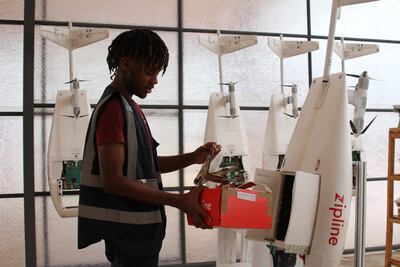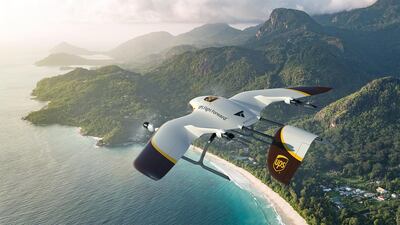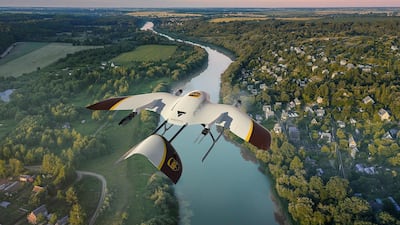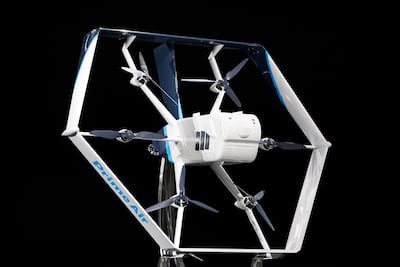Drones have been on a curious journey, both literally and metaphorically. Originally created for military purposes, they evolved to become the playthings of amateur hobbyists, and today they are helping save lives in a time of crisis.
In the UAE, police are using them to remind people to stay at home in order to avoid spreading Covid-19, while the Dubai Municipality has attacked the coronavirus directly by using drones equipped with disinfection spray.
By doing jobs that humans are reluctant or unable to do, drones have become more visible and more useful across sectors around the world.
This technology was already on the rise; at the end of last year, the US Federal Aviation Administration advised that commercial drones were “at an inflection point of demonstrating powerful stages of growth”.
But the coronavirus may prove to be a powerful accelerant for its use.
Why haven't drones caught on yet?
The potential of drones to solve big problems is demonstrated every year by the UAE’s “Drones For Good” award, where Dh1 million prize money is given for humanitarian innovation.
But the machines are still a rare sight in most cities, and most of the pioneering work has been done in sparsely-populated areas. Drones have been used to deliver blood to regional hospitals in remote parts of Rwanda since 2016, and the outbreak of Covid-19 has seen similar schemes used in urban environments.

The World Economic Forum recently reported of a hospital in the Zhejiang Province of China, where drone company Antwork joined forces with the country’s Civil Aviation Administration to fly medical equipment between the hospital and the local testing centre.
Drones cut transit time in half.
“At the moment of life and death, the air transport network can significantly confine the flow of people, avoid unnecessary physical contact and prevent secondary transmission,” said a hospital spokesperson.
Drones have played an important role amid the pandemic
In recent weeks, these unmanned aircraft have been cropping up in unexpected contexts. Deserted streets are being filmed by camera-equipped drones and beamed around the world on news networks and social media. In France and Spain, police have been using them not only to disseminate public messages, but to specifically address people who are disobeying instructions to stay at home.
In Australia, drone company Draganfly has been working on a way of using thermal sensors and computer vision to detect cases of the virus remotely, by monitoring temperature, heart rate and respiratory rate.
“I think of the drone as a flying robot,” says Rabih Rashid, chief executive of UAE company Falcon Eye Drones Services.
“What that robot carries is as big as your imagination. If you put arms on it, it can repair something. If you put sensors on it, it can collect information. When [UAE] police wanted to disinfect areas without sending in health workers, the idea of using drones equipped to spray agricultural pesticides will have come very quickly.”
Pre-coronavirus, the number of commercial uses for drones was already growing quickly. The FAA predicted that almost half a million of them would be in active use this year in the US, while the Financial Times reported he commercial drone market looks set to grow tenfold over the next five years.
“Drones have already disrupted so many industries,” says Rashid. “The biggest one would be surveying and mapping. In the eight years since drones proved their map-building capabilities, they have become essential. Companies that do not use them are way behind.”
Could delivery drones be next?
The Covid-19-related boom in e-commerce has once again raised the question of when drones will be used to deliver goods to the public. Some companies are ahead of the game.
Plane manufacturer Airbus has been using them in Singapore to whisk items to ships moored offshore. German start-up Wingcopter is working with UPS to develop drones that can fly packages at speeds of up to 240km/h across distances of 120km.
Wing, part of the Google empire, made its first commercial drone delivery to a US doorstep in January, and those trials continue. In many countries, including the UK, it’s illegal to fly a drone out of the line of sight of the pilot, which hampers development of services. But the UAE, while having one of the strictest safety laws, is better positioned than most to benefit from drone innovation, according to Rashid.
“A few years ago, the government mandated all departments to work with drones,” he says. “So when this crisis began, the police could respond immediately, rather than figure out what the technology means and where to procure it from.”
And that top-level enthusiasm has filtered down to the commercial sector.
“While there is a great deal of control on general usage, as long as they know where the drone is and what it is doing, the government will issue exemptions in a couple of weeks. To get that from the FAA takes months. This has allowed us to innovate more,” says Rashid.
How drones could work in the UAE
The relatively small size of the UAE also makes it easier to keep track of the number of drones in the air, but larger nations have struggled to deal with this logistical challenge. Across the globe, work has been under way to create unmanned traffic management systems – UTMs – to establish a drone equivalent of air traffic control, which will allow drones to fly safely and legally.
This is critical if drones are ever to be able to perform deliveries at scale – along with solving the problem of where they land.
“In a remote part of Rwanda, a drone can land wherever you want,” says Rashid. “But how do you deliver to people who live in apartments blocks? Do we land or do we drop the item? Do we zip it down? Technologically, we are ready to transport items from point A to point B. But the infrastructure situation needs to be addressed first.”
There are other issues with commercial drones. Their capacity is small; Amazon’s Prime Air drone can only carry 2.2kg. There are also privacy implications of low-flying aircraft being equipped with cameras and sensors. When Wing tested its service in Australia, there were a number of complaints about noise. But if drones are seen as doing a public good in the current global health crisis, some of those concerns may evaporate.
“People are waking up to the possibilities,” says Rashid. “If drones save the day, then people will take them more seriously.”




